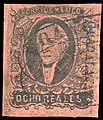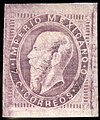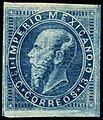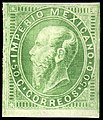Postage stamps and postal history of Mexico
The Mexican postal system has its roots in the
In 1891, the postal and stamp issuing authority was created as an administrative division of the Secretaría de Comunicaciones (
The Mexican Revolution and ensuing Civil Wars (1910–1920) resulted in numerous provisional and local stamps issued by the factions in control of different areas of the country.
Colonial period

The
In 1742, the administrator of posts in Madrid was ordered to improve the Mexican system, resulting in the 1745 establishment of a weekly post between Mexico City and
During the Colonial period and continuing up to the introduction of adhesive stamps, letters were typically sent collect, the postage to be paid by the recipient upon arrival. The covers, or envelopes in which the letters were sent, were stamped by hand with the name of the originating town, and typically with a number representing the charge for postage, e.g., "3" for 3 reales. Occasionally, mail was sent postage pre-paid, in which case the envelope would be marked "Franca" or "Franco" or "Franqueado." According to Yag & Bash (1965), some handstamps (on undated covers) date to the 1720s and the earliest known stamped postmark on a dated cover is a Veracruz mark from 1736.[2] Yag and Bash researched the Chapman records, and found these numbers of post offices:
| Year | Principal | Branch |
|---|---|---|
| 1824 | 17 | 338 |
| 1846 | 45 | 440 |
| 1854 | 47 | 430 |
| 1868 | 47 | 431 |
| 1875 | 54 | 241 |
Most post offices, principal and branch, had handstamps.
Covers from the Colonial period up until the third quarter of the 1800s typically showed only the addressee's name and city; a street address was not written. These letters were not delivered to the addressee. Instead, the letters would be held at the local post office and advertised on posted lists or in newspapers. Many of the recipients were well known businessmen or politicians. Towards the end of the 19th century, larger cities employed postmen to deliver the mail.[3]
Independence and early republic
Mexico declared independence from Spain on September 16, 1810. This resulted in the long
In the 1820s both the British and French began packet service to Veracruz. A British postal agent operated at Veracruz 1825–1874 and at Tampico from around 1840 to 1876. While both were supplied with British stamps, only the Tampico stamps were used (obliterator "C76"). The British service ran continuously until 1914, while French service ended in 1835, was restored in 1862 as the Ligne de Mexico and continued until 1939.
Next to the Mexican, British and French post offices and agents, Mexico had a good number of forwarding agents, most of which operated in the 19th century. Some towns and the agents therein as noted by Ken Rowe:
- Acapulco: Foster; Guys & Doty; P.M.S.S. Co.
- Guaymas: Robinson
- Matamoros: Erhard, Putnam & Co; Uhde & Co.
- Mazatlan: Copman & Lomer; Kennedy; Talbot, Parrot (US Consul); Scarborough & Co.; Smith & Mason
- Mexico City: Sengstack & Schutte; de Drusina & Co.
- Monterey: Bach Schonfeld Y Ca.
- Tampico: Baumbush, Magnus & Co.; Droege Y Ca.; Hohls, Muller & Co.; Montluc
- Vera Cruz: Braune, Busing & Co.; Hargous; Hoffman Y D'Oleire; Manning Basildon & Co.; Manning, Marshal & Co.; Martinez, Perret and Co.; Smith
Classic stamp period 1856–1874
Just as there is no consensus on what constitutes "classic stamps" in general, there is no agreement on what is the "classic period" for stamps of Mexico. In 1926, Samuel Chapman in his The Postage Stamps of Mexico, referred to the "provisional period" as running from 1856 to 1868.[4] In 1983, Schatzkès & Schimmer published a study of the Cancellations of Mexico from 1856-1874, but they did not specifically call that the "classic period." Pulver in his Introduction to the Stamps of Mexico (1992) included a chapter entitled "Classic Era 1856-1883." Including 1883 as the end of the classic period apparently is based on the fact that the district overprints continued to that year.[5] However, the only stamps Pulver actually discussed in his "classics" chapter were issued before 1874, which year marked a fundamental change in the appearance of Mexico's stamps.[6] Others view the classic period as extending to 1900 or even later.
How to define the "classic" period thus necessarily is subjective. This article will treat the classic period as running from 1856 to 1874. Before 1874, most of the stamps were locally designed and produced, often with crude or "
District overprints

Virtually all the early stamps of Mexico have district overprints, which were added as an anti-theft device. These overprints came into use in 1856, with the first stamps of Mexico, and continued officially until the end of 1883.[10]
The Mexican postal system divided the country into about 50 "districts", each of which had a main office and a number of suboffices. The district office ordered stamps from Mexico City, they would be shipped by stagecoach unoverprinted, and then the district office would handstamp each stamp with the name of the district. The overprinted stamps would then both be sold directly to postal customers, and shipped to suboffices.
In theory, only overprinted stamps were valid for postage, but given the error potential of applying the marking to each individual stamp, a small number of unoverprinted uses are known. Also, some offices failed to comply with orders and simply sold their stamps unoverprinted.
In 1864, the system was refined by shipping the stamps from Mexico City with an invoice number and year already overprinted.
Sometimes the district office's overprint included a number designating the suboffice for which the stamps were intended, and occasionally suboffices applied their own handstamps. Larger offices had several different designs of handstamp in use; Mexico City used five different devices to handstamp the stamps of 1856, each with a different appearance, while the districts of
The color of the district name was almost always black, but red, blue, and violet overprints are known. For a period in 1858, the postmaster of
For many years, philatelists were mystified by the overprints, until Samuel Chapman, a British businessman living in Mexico, took an interest and researched the postal archives. His 1926 book, since reprinted, includes extensive detail on the shipments to the various districts.
Many of the overprints are rare, and command high prices among specialists in Mexican stamps. They have also been forged.
Postal cancellations
After stamps were introduced in 1856, some post offices created new cancellation marks, while others used their existing handstamps bearing the name of the town for years to cancel the new stamps, so that very old handstamps can be found on stamped covers.[11]
Postage stamps
Hidalgo issues 1856 and 1861
President
Quantities produced according to Follansbee:
- ½ real blue - 825,573
- 1 real yellow - 1,425,275
- 2 reales green - 1,629,773
- 4 reales red - 157,189
- 8 reales violet - 100,784
-
Mexico's first stamp, medio real, 1856
-
Dos reales 1856, Mazatlán district
-
Quatro reales 1856 without district overprint
-
Ocho reales 1856, Puebla district and postmark
In 1861 the stamps were reissued in new colors on variously colored paper. As in the first issue they were issued both with and without district overprints,[12][13] but in lower numbers.
Quantities produced according to Follansbee:
- ½ real black on buff - 194,280
- 1 real black on green - 821,116
- 2 reales black on pink - 925,573
- 4 reales red on yellow, orange - 103,675
- 8 reales black on red brown - 62,762
A study of the 1856 and 1861 issues, with information on the district overprints from Chapman's book is on Jesper Andersen's site. More examples of the 1856 and 1861 issues, including covers, may be seen on the Asian Philatelist website. Another collection of the 1861 issue is on the Stamps of Mexico site
-
Medio real 1861 unused
-
Un real 1861
-
Dos reales 1861
-
Quatro reales 1861, Tabasco district
-
Quatro reales 1861,Mazatlandistrict and postmark
-
Quatro reales 1861, Guadalajara district and postmark
-
Ocho reales 1861, Guadalajara district
"Juárez" issue 1864
In 1864, Mexico issued with a stamp with a finely engraved image of Hidalgo. These stamps were printed by the American Bank Note Company in New York by order of President Juárez.[14] The stamps were perforated and issued in four values: 1r, 2r, 4r and 1 peso, and were issued both with and without district overprints. Although they were intended for general use, they were soon replaced by the first issue of the Second Mexican Empire (see below) and are known to have been used only in Monterrey and Saltillo. Used copies are rare and expensive.[15][16]
-
Un real
-
Dos reales
-
Quatro reales
-
Un peso
Second Mexican Empire
Between 6 January and 8 January 1862,
Eagle issue 1864
On 15 May 1864,[17] the regency replaced the existing stamps with the Eagle stamps depicting the Coat of arms of Mexico, an eagle killing a snake. A crown was added to the eagle to indicate the monarchy and the spelling was changed from "Mejico" to "Mexico." The stamps were engraved and issued imperforate. Five values were initially issued; 1/2r, 1r, 2r, 4r and 8r, to which a 3c. was added in 1865. The stamps were shipped from Mexico City to the district offices where the district name usually would be added to validate the stamps. Starting in July 1864, the stamps were overprinted with the year and an invoice number prior to shipment to the districts. The various overprints were made in different sizes and based on such variations, specialists have distinguished five separate issues, referred to as "1st" through "5th" period eagles. This issue is very popular with collectors and detailed studies have been made of the issue, including information obtained from surviving postal records.[18][19][20][21]
- Another study of the Eagle stamps is on Jesper Andersen's site.
-
Un real 1864, Guanajuato district
-
Un real 1864, Tampico district
-
Dos reales 1865, San Luis Potosí district
-
Dos reales 1866, Veracruz district
-
Quatro reales 1864, Zacatecas district
-
Ocho reales unused pair, without district overprint
Maximilian issue 1866
On 1 August 1866 the regency issued a new set of stamps depicting a profile bust of Emperor Maximilian. This issue was lithographed, rather poorly, and issued imperforate. The regency had previously changed the official currency under which one peso equaled 8 reales to a decimal system in which one peso equaled 100 centavos.[22] In making the conversion postal rates were rounded up, for example, the rate of one real being equal to 12.5 centavos was rounded up to 13 centavos. The stamps, as a result, were issued in values of 7c, 13c, 25c, and 50c. These stamps were issued with the year and invoice number and with or without the district name, but some issued in exchange for Eagle stamps were issued only with the Mexico City district name.[23][24][25]
On 16 October 1866, the lithographed Maximilians were replaced with a finely engraved version of the same design and values. These were issued imperforate and with year and invoice number, with or without district name.[26][27][28] Stamps without overprint are unissued remainders.[29]
-
7c unused engraved
-
13c used engraved
-
13c unused engraved
-
25c used lithographed
-
50c unused engraved
Sellos negro
Maximilian's Empire was never in control of the entire country and was in constant battle with Republican forces led by the ousted president Benito Juárez. Juárez eventually set up a government in exile in Chihuahua. Parts of the country not in control of the regency would not use stamps bearing Maximilian's image and issued a few provisional stamps. More commonly those areas reverted to using pre-stamp postal markings with "franco" stamps. These stampless covers issued after the advent of adhesive stamps are known to philatelists of Mexico as "Sellos Negro", or "Black (hand)stamps".[30][31]
Republic restored
In June and July 1867, Maximilian's Empire was defeated and the Republic restored with Benito Juárez resuming the presidency. As a provisional measure, remainders of the 1861 Hidalgo issue were overprinted with "Mexico" handstamped in Gothic letters. Gothic overprints also were added to new printings of the 2 and 4 reales stamps. Some of these stamps are extremely rare and expensive.[32][33]
Hidalgo issue 1868 & "Anotado" 1872

On 8 September 1868, Mexico issued a new Hidalgo design, referred to by collectors as the "Full Faced Hidalgo". The stamps were lithographed and issued both with and without perforations in denominations of 6c, 12c, 25c, 50c, and 100c. Two issues have been identified, the first with the numbers thinner and without a period; the second issue with thicker numbers followed by a period. There also are a multitude of minor variants and plate flaws, all of which, combined with the various overprints used, led Pulver to state that "In many respects, the issue of 1868–72 offers almost everything a specialist could want." [35][36][37]
- A study of the 1868 issue is on the 1868 Stamps site.
In early 1872, it was announced that new stamps would soon be issued. When they were not ready on time, a number of the Full Faced Hidalgo stamps which had been demonetized and returned to Mexico City were re-issued overprinted with the word "Anotado", meaning "accounted for." These stamps were only used briefly until the new stamps were available.[38][39]
Hidalgo issue 1872

On 2 April 1868, Mexico issued a new series, also depicting Hidalgo. These were lithographed and issued both imperforate and perforated, in values of 6c, 12c, 25c, 50c, and 100c. This issue has been less popular with collectors and has been called "the nadir of Mexican stamp design." [40][41]
Bisects and splits
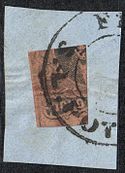
During the classic period, some stamps were
Late nineteenth century
The 1872 Hidalgo issue marked the end of the earlier period of Mexican stamp production with mostly crude designs and poor printing, and with a distinct Mexican character. On
In 1879, Mexico joined the Universal Postal Union which required standard rates for international mail, that were actually lower than Mexico's domestic rates.[50] Mexico accordingly released a new issue depicting Juárez for exclusive use on international mail.[51] District overprints continued through 1883 after which they were no longer required.[52][53]
-
150c Hidalgo "Bank Note" 1874, with district name, invoice number (51) and year ('77)
-
2c Juárez UPU issue 1879
-
4c "Mulitas" issue 1895-1898
-
5p "Mulitas" issue 1895-1898
In 1895, Mexico issued a series of stamps depicting various methods of delivering mail, including a letter carrier, a mail coach and a mail train. Philatelists call this the "Mulitas" issue (little mules), after the 4 and 12 centavos stamps depicting a mule carrying a pack of mail followed by a mailman on horse.[54] This issue has a great number of variants, including different perforations and watermarks, and is assigned 50 major (and many minor) catalog numbers in Scott.[55]
Twentieth century
Early twentieth century

In 1899, Mexico issued a definitive series depicting the Mexican coat of arms with the eagle and snake for the lower values and images of Mexican landmarks such as the National cathedral for the higher values. The authorities had been dissatisfied with the quality of the locally produced Mulitas issue, and had this finely engraved issue manufactured by Bradbury Wilkinson and Company in London.[56]
This was followed in 1910 with an issue commemorating Mexico's centenary of independence and depicting important Mexican patriots and historical events such as the Declaration of Independence.[57]
Mexican revolution and civil wars 1910-1920
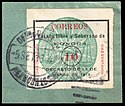
Between 1910 and 1920 Mexico was torn apart by a violent revolution and subsequent civil wars. In the first decade of the 20th century, President
Philatelically, this period resulted in numerous provisional and local stamps issued by the factions in control of different areas of the country. For example, in 1913-1914, the state of
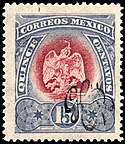
In addition to the locals and provisionals, a great variety of overprints and surcharges were added to stocks of existing stamps by the powers then in control. Although many of these were printed on the stamps, they are commonly known by Mexican philatelists as "gomigrafos" or rubber stamps. Among the best known of these overprints are the "GCM" monograms, standing for "Gobierno Constitucionalista Mexicano" or the "Constitutional Mexican Government." Varieties of this overprint were first used by the Conventionalists supported by Villa, and later by the Constitutionalists and known as the Carranza overprints.[61]
Despite great disruption caused by the civil wars, opportunists took advantage of the strong interest in stamp collecting by producing for the philatelic market a number of forgeries of both the local issues as well as the overprints. In addition, many of the covers from this period were manufactured for collectors with the assistance of postal authorities and did not represent ordinary postal use.[62]
The great complexity of the stamp issues of this period has been studied by philatelists in recent years, most notably by Follansbee in The Stamps of the Mexican Revolution 1913-1916.
The twenties and thirties
Stamps produced in the two decade period from 1917 to the mid thirties retained a conservative character similar to those of other countries including the United States. The stamps were engraved and had a standard format consisting of a frame with inscriptions surrounding a portrait of an historically important person, building or scene.
In the mid-1930s, this staid format slowly began to change into a more varied concept with a more contemporary look. In 1934, a series of stamps was issued depicting ancient and contemporary Indians engaged in activities such as making pottery. The frames of each stamp differed noticeably and the central image sometimes crossed over onto the frame. The lettering began to take on a more modern aspect also, such as a distinct Art Deco font on the 1935 stamp illustrating Zapata.[63] In 1934-1935, Mexico issued a series of airmail stamps depicting Aztec gods and symbols. The lettering on many of these was in a strong Art Deco style, and one stamp, the 5 centavos, was a borderless image of Aztec symbols mixed with wings, unlike any stamps Mexico had previously issued.[64]
- Several Mexican stamps are illustrated in Art Deco stamps.
The appearance of Mexican stamps took an abrupt and major change with the 1938 issue commemorating the 25th anniversary of the Plan of Guadalupe.[65] This issue had a thoroughly "modern art" look with drawings in a
From World War II to end of the century
A number of stamps were printed in the early 1940s with drawings or paintings of images in a bold, Mexican Art Deco style, in a large square format with a common appearance. Many of these were the artwork of
- See also Eppens Gallery of Postal Stamps
Architecture and Archaeology series
From 1950 to 1975, Mexico issued a series of small format definitive stamps with similar basic design for surface mail. Although this series is known by philatelists as the "Architecture and Archaeology" series, it in fact included some other subjects such as the centennial of the Mexican constitution. Many of stamps [69]
The "Architecture and Archaeology" series also included a number of larger format airmail stamps (1950–1976) with common design, although some specialists treat the two series separately.
Exporta series
From 1975 to 1993, Mexico issued a series of definitive regular and airmail stamps in a uniform style depicting a great variety of products Mexico exports, such as beef, bicycles. tomatoes and chemicals, each stamp bearing the Exporta Logo. The series was added to over the years, and there are a great number of variants of papers, sizes, colors, watermarks, and plate flaws. A number of the stamps had burelage printed on their surface.[73] Specialists have also identified 14 different weights and grades of paper used on the stamps.[74] As a result of the collecting challenges, the Exporta issue has received a great deal of attention by collectors and is the most popular modern series.
- Ronald Hill, "Who Put That Big Red Tomato On That Little Bitty Stamp?"
- The Mexico Exporta Definitives
- John R. Endsley,Jr., A Comprehensive & Specialized Catalogue of the Exporta Issues of Mexico
- See Checklist of Exporta Definitives in Pulver pp. 103–107.
- See Michael D. Roberts, A Bibliography for the Exporta, Mexicana, vol. 57, no. 3, p. 121 (July 2008).
- See James O. Vadeboncoeur, The Exporta Issue of Mexico.
- See etiangui ( Enrique Sanchez Garcia ) "The Mexico Exporta serie, complete classification guide"
Twenty-first century
In 2005, a Mexican stamp issue, part of a series commemorating Mexican cartoons, was the subject of widespread media attention. The issue of five stamps depicting
Collecting Mexican stamps
Mexico is popular among philatelists particularly for its classic issues with their complex use of district overprints and invoice numbers, as well as the variety of cancellations used. The postal cancellations used on Mexico's classic period stamps have been very popular among philatelists and have been the subject of extensive study.[79] As stated by Schatzkès & Schimmer, "Amongst the collections of cancellations, Mexico is pre-eminent. No other country possesses such a remarkable selection of ornamental cachets of unusual dimensions and of an extraordinary variety." [11]
Other areas that have received extensive philatelic attention are Mexico's pre-stamp postal markings, the issues of the Mexican Revolution (1913–1916), and the modern Exporta issue (1975–1983), with its complex variety of papers, sizes, perforations and watermarks. James H. Beal stated that "few will doubt that any single country's issues raise more and vaster questions, require more care in the avoidance of pitfalls, or more defy neat solutions, than the stamps of Mexico."[80]
Forgeries
Most of the classic issues of Mexico have been forged, primarily for the philatelic market, and numerous cancellations and district overprints have also been faked.[81] In the early 20th century, Mexico sold the original printing plates for the 1856, 1861 and 1867 issues, as well as genuine handstamps, cancellation devices and paper to stamp dealers in the United States who made unauthorized reprints for sale to collectors. Some of the district names added in fact were fabricated and never existed.[82]
Forgeries also are common for many issues through the end of the 19th century and also the revolution and civil war period.[83] Detailed studies of some of the forgeries include:
- Nicholas Follansbee, The Stamps of the Mexican Revolution 1913-1916.
- Fernand Serrane, Serrane Guide: Stamp Forgeries of the World to 1926, Pennsylvania, 1998, pp. 235–239, covering forgeries and reprints from 1856-1879.
- Roberto Liera Gutiérrez, Características de Algunas Falsificaciones de Timbres de México, covering forgeries from 1856 - c.1915.
- James H. Beal et al., Mexico, in James M. Chemi, The Yucatan Affair, Pennsylvania, 1980 (2d. printing), pp. 146–286, covering the extensive cancellations, district names and revolutionary period overprints forged by Raoul de Thuin
- Joe D. Stuart, The Counterfeits of Mexico's 1856, 1861 and 1867 Issue, Mexicana, Vol. 50, No. 1 (Jan. 2001), p. 20.
- Forgeries of the 1856-1867 issues illustrated
- José Lorenzo Cossío y Cosío. La falsificación de algunos timbres postales antiguos de México. 1932.
See also
- List of people on stamps of Mexico
References and sources
- Notes
- ^ Manuel Carrera Stampa, "El Correo en Mexico/The Mail in Mexico," in La Filatelia Mexicana, Artes en Mexico, No. 96 (1967), pp. 15, 18.
- ^ Yag & Bash, pp. v–viii,68 (Mexico "est. 1721"), 135 (Vera Cruz "1736"). See also Tizon and Guinovart, Prefilatelia española; estudio de las marcas postales de España y sus dominios de Indias, siglos XVIII y XIX (earliest known postal cancel is Veracruz stamp used 1736-1739 - "Esta marca es las mas antigua conocida hasta la feche del Nuevo Mundo."); Soler & Llach auction catalog, June 19, 1991, Barcelona (letter dated August 8, 1739, with Veracruz postal mark).
- ^ Similar procedures were used in the United States. See Statutes of 1825-1851 regarding advertising of unclaimed letters
- ^ Chapman
- ^ Follansbee p. 96.
- ^ Pulver pp. 7–20.
- ^ An exception was the 1864 Juárez issue, also printed by the American Bank Note Company in New York. See Minkus New World-Wide Postage Stamp Catalog (1974 ed.), Mexico, nos. 15–18.
- ^ See Minkus New World-Wide Postage Stamp Catalog (1974 ed.), Mexico, nos. 64–70.
- ^ etiangui ( Enrique Sanchez Garcia ) "Mexico Postal Offices between 1856 - 1883"
- ^ Some local postmasters continued to overprint stamps after they were no longer required. Follansbee p. 96.
- ^ a b Schatzkès & Schimmer p. x.
- ^ Follansbee nos. 1–12.
- ^ Scott Mexico, nos. 1–12.
- ^ Minkus New World-Wide Postage Stamp Catalog (1974 ed.), Mexico, nos. 15–18.
- ^ Follansbee nos. 13–16.
- ^ Scott Mexico, nos. 14–17.
- ^ Follansbee notes usage as early as 8 May 1864.
- ^ Follansbee nos. 17–46.
- ^ Scott Mexico, nos. 18–25.
- ^ Corbett, Eagles.
- ^ Pulver, pp. 3–5.
- ^ This change had occurred simultaneously with the decree ordering the Eagle stamps, but was not implemented on that issue. Pulver p. 5.
- ^ Follansbee nos. 47–51.
- ^ Scott Mexico nos. 26–30.
- ^ Pulver pp. 5–6.
- ^ Follansbee nos. 52–55.
- ^ Scott Mexico nos. 31–34.
- ^ Pulver pp. 6–7.
- ^ Follansbee
- ^ Follansbee pp. 36–37.
- ^ Pulver pp. 8, 67.
- ^ Follansbee pp. 41–43.
- ^ Pulver pp. 7–8.
- ^ This is believed to be Colima, reading upwards.
- ^ Pulver pp. 12–14.
- ^ Follansbee p. 62.
- ^ John Heath & Doug Stout, The 1868 Issue, A Specialists HandbookMEPSI (2005).
- ^ Pulver p. 10.
- ^ Follansbee pp. 44–59.
- ^ Pulver pp. 18–20.
- ^ Follansbee pp. 63–72.
- ^ James H. Beal et al., Mexico, in James M. Chemi, The Yucatan Affair, Pennsylvania, 1980 (2d. printing), p. 146.
- ^ See Minkus New World-Wide Postage Stamp Catalog (1974 ed.), Mexico, note before no. 64.
- ^ See Bank notes stamp issues of the United Stamps.
- ^ See Minkus New World-Wide Postage Stamp Catalog (1974 ed.) Argentina, nos. 17–31 (1867–1887).
- ^ See Minkus New World-Wide Postage Stamp Catalog (1974 ed.) Brazil nos. 23–46 (1866–1879).
- ^ Scott United States nos. 134–191.
- ^ Pulver p. 23
- ^ Billings
- ^ Pulver p. 24.
- ^ Follansbee pp. 24–25.
- ^ Pulver pp. 21–28.
- ^ Follansbee pp. 74–94.
- ^ Pulver p. 30
- ^ Scott nos. 242-291.
- ^ Pulver pp. 32-36.
- ^ Scott nos. 310-320.
- ^ Follansbee, pp. 1-40.
- ^ Follansbee, pp. 24-31.
- ^ Follansbee, pp. 148-157.
- ^ Pulver pp. 39-40.
- ^ Pulver pp. 37-46.
- ^ Scott no. 723.
- ^ Scott nos. C65-73.
- ^ Scott nos. 737-739.
- ^ The prior year, four stamps of the 1934 issue had been reprinted using photogravure. See Scott nos. 729-733.
- ^ Ramón Valdiosera Berman, Francisco Eppens: El Hombre, Su Arte y Su Tiempo, Mexico (1988), pp. 33-50, with a catalog of his stamps.
- ^ Minkus New-World Postage Stamp Catalog (1974 ed.), Mexico, no. 1005.
- ^ etiangui ( Enrique Sanchez Garcia ) "The Arqueologia y Arquitectura serie, complete classification guide"
- ^ Pulver, pp. 57-62.
- ^ Pulver, p. 57.
- ^ Pulver, p.---.
- ^ Pulver, pp. 62-70.
- ^ Ronald Hill, "Who Put That Big Red Tomato On That Little Bitty Stamp?"
- ^ "U.S. says Mexican stamp is racist". NBC News. Retrieved 2009-10-14.
- Washington Post. Retrieved 2009-10-14.
- National Public Radio. Retrieved 2009-10-14.
- ^ "Exclusive interview with President Fox". Associated Press archive. 2005-07-02. Archived from the original on 2011-07-18. Retrieved 2009-10-14.
- ^ Schatzkès & Schimmer
- ^ James H. Beal et al., Mexico, in James M. Chemi (ed.), The Yucatan Affair, Pennsylvania, 1980 (2d. printing), p. 146.
- ^ Liera, pp. 8-41.
- ^ Liera, p. 10.
- ^ Liera, pp. 42-52.
- Sources
- Asociacion Mexicana de Filatelia, Tres Siglos de Filatelia en Méjico (Mexico City: Grupo Grafico Romo 2006). Extensive illustrated history of Mexican stamps.
- Billings, Carter and Rich Daffmer, Foreign Mail Issues of Mexico 1879-1883 (2002).
- R.R. Billings, Mexico - Postal Issue of 1874-1883 (1960)
- Samuel Chapman, Postage stamps of Mexico 1856-1868, Lawrence, Massachusetts ([1926]; reprint 1976).
- Leo V. Corbett, Imperial Eagles of Maximilian's Mexico, Stanton, California (1993).
- Nicholas Follansbee, A Catalogue of the Stamps of Mexico 1856-1900, Ashland, Oregon (1998).
- Nicholas Follansbee, The Stamps of the Mexican Revolution 1913-1916, Collectors Club of Chicago (1996).
- Roberto Liera Gutiérrez, Características de Algunas Falsificaciones de Timbres de México (2007).
- Dale Pulver, Introduction to the Stamps of Mexico, Linn's Stamp News, Ohio (1992).
- Rowe, Kenneth. The Postal History and Markings of The Forwarding Agents. (1st edition 1966, supplement 1974, 2nd ed. 1984, 3rd ed. 1996.) ISBN 0917528123
- Scott catalog
- Joseph Schatzkès (rev. Karl H. Schimmer), The Cancellations of Mexico: 1856-1874, [San Antonio] (1983).
- Otto Yag & John K. Bash, The Pre-Stamp Postal Markings of Mexico, Elmhurst, Illinois (1965; 2nd printing 1973)
Further reading
- Ferrer, Arturo Zavala. Catálogo de Enteros Postales de México, I.- 1874 - 1894, II.- 1895 -1899, III.- Siglo XX. Fco. Javier Gilabert S. e Impreso Granada (2010). FIAF.
External links
- Mexico Postal Mexican Post Office
- Servicio Postal MexicanoWikipedia: Mexican Post Office
- Cerrado Y Sellado: The Post Office Seals of Mexico Mexican official seals
- Why Collect Mexico? Article by Marc E. Gonzales, MEPSI.
- [1] Maximilian Stamps Collection - RTV/Stamps
Philatelic societies
- MEPSI Mexico Elmhurst Philatelic Society International US based Mexican philatelic society
- FIAF Interamerican philatelic federation












